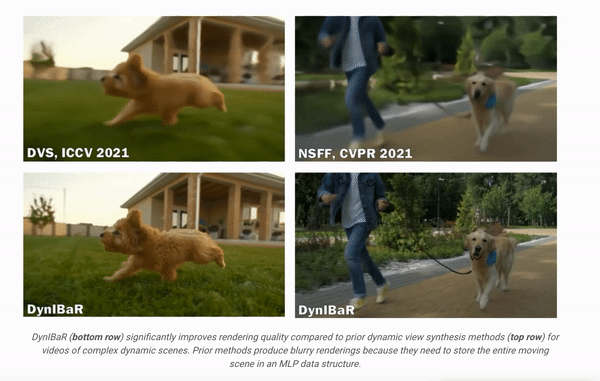TL;DR:
- DynIBaR is a pioneering AI technique by Google and Cornell that redefines dynamic scene rendering.
- It offers photorealistic free-viewpoint renderings from standard phone camera videos.
- Key features include bullet time effects, video stabilization, depth of field adjustments, and slow-motion capabilities.
- DynIBaR excels in handling lengthy videos with complex object motions and unregulated camera paths.
- It introduces motion trajectory fields, a temporal photometric loss, and innovative motion segmentation.
- This technique optimizes data structuring using a multilayer perceptron (MLP) neural network.
- It leverages neighboring frame data and builds upon IBRNet’s image-based rendering for efficiency.
Main AI News:
In the realm of computer vision, a groundbreaking innovation has emerged, poised to redefine our perception of dynamic scenes captured in real-world scenarios. Over the years, computer vision methodologies have made remarkable strides in reconstructing and visualizing static 3D environments, thanks to the advent of neural radiance fields, commonly referred to as NeRFs. These neural networks have enabled us to unlock the intricacies of stationary scenes like never before.
However, the real challenge lies in extending this capability to the dynamic world of videos, where complex object movements and unpredictable camera paths are the norm. Enter Dynamic NeRFs, the space-time neural radiance fields designed to tackle the dynamic scene dilemma. While these approaches show immense promise, they face significant hurdles when applied to extended videos shot in the wild.
Consider the chaotic yet captivating world captured by your everyday smartphone camera. While it excels at documenting your life’s moments, it struggles to capture the true essence of dynamic scenes. The gap between our expectations and reality persists, leaving room for innovation.
Now, Google and Cornell University have joined forces to introduce DynIBaR: Neural Dynamic Image-Based Rendering, a breakthrough AI technique unveiled at the prestigious CVPR 2023 conference. DynIBaR promises to bridge the gap between our desire for captivating dynamic content and the limitations of our smartphone cameras.
With DynIBaR, a single video clip becomes a canvas for photorealistic free-viewpoint renderings. This cutting-edge method redefines what’s possible, offering an array of stunning video effects. Freeze time with bullet time effects, achieve cinematic stability with video stabilization, play with depth of field, and dive into slow-motion wonderlands – all with the power of a standard phone camera.
The versatility of DynIBaR extends to dynamic films with all the bells and whistles: lengthy durations, diverse scenes, unpredictable camera trajectories, and intricate object motions. The secret sauce lies in motion trajectory fields, represented by learned basis functions spanning multiple frames. These fields elegantly model the dynamic dance of objects in your video, ensuring a seamless and immersive experience.
But the magic doesn’t stop there. A new temporal photometric loss comes into play, meticulously crafting temporal coherence within the realm of dynamic scene reconstruction. And here’s the icing on the cake – a novel Image-Based Rendering (IBR)-based motion segmentation technique, nestled within a Bayesian learning framework. This technique intelligently dissects the scene into static and dynamic components, elevating the rendering quality to new heights.
Now, let’s talk about efficiency. DynIBaR’s ingenious data structuring encodes intricate dynamic scenes within the weights of a multilayer perceptron (MLP) neural network. This MLP is like the conductor of an orchestra, translating 4D space-time coordinates into vivid RGB colors and essential density values for rendering. Yet, the challenge arises as the scene’s duration and complexity increase, leading to a surge in the MLP’s parameter count. This computational complexity might seem daunting, making it unfeasible to train models on real-world videos spontaneously captured.
But here’s where DynIBaR redefines the game. It discards the need to burden a massive MLP with every pixel detail, opting instead to harness the power of pixel data from neighboring frames within the video. The foundation for this revolutionary approach? IBRNet is an image-based rendering method originally tailored for static environments.
Conclusion:
DynIBaR’s introduction heralds a significant leap in the market of dynamic scene rendering. Its ability to extract stunning visual effects from everyday smartphone videos opens up new possibilities for content creators and businesses seeking captivating, immersive experiences. As DynIBaR gains traction, we can expect a surge in demand for dynamic scene rendering solutions, creating opportunities for innovation and growth in the technology and entertainment sectors.

